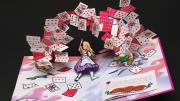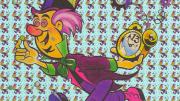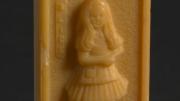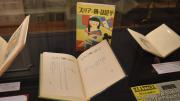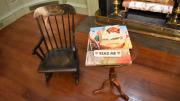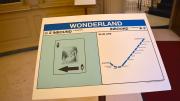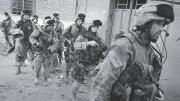One and a half centuries after Alice first fell down the rabbit hole, she has arrived at one of Cambridge’s most serious places: Houghton Library, Harvard’s primary repository for rare books and manuscripts.
In its summer exhibition, Such a Curious Dream! Alice’s Adventures in Wonderland at 150, the library explores the enduring legacy of one of the great masterpieces of children’s literature by putting on display an eclectic collection of Alice-related manuscripts, artworks, and paraphernalia.
When British mathematician Charles Dodgson first published Alice’s Adventures in Wonderland in 1865 under the name Lewis Carroll, it was an instant sensation—the Harry Potter of the nineteenth century, as curator Heather Cole put it. In an era when most children’s books were cautionary tales designed to teach lessons, Carroll’s work was groundbreaking, she said, for depicting nonsensical happenings in a fantastical world that deliberately contained no moral messages whatsoever. In the ensuing decades, the book has been republished in more than 300 editions and translated into 40 languages, including Pitman shorthand and Klingon (a constructed language spoken by fictional humanoids in Star Trek).
Maria Tatar, Loeb professor of Germanic languages and literatures and of folklore and mythology, first encountered the book as a nine-year-old, and was sternly told by her teacher, “This is not a book for children.” Now that she has taught and written about Alice, as well as read it more than a dozen times, Tatar said she can see why it can be construed as a book for adults: “It is a deeply philosophical work. We have a figure who’s in a state of perpetual existential crisis: Alice is completely disoriented and constantly wondering what will happen next.” Wonderland is, in fact, a scary and treacherous world. Tatar remembered “reading it once and monitoring the number of time [Alice] bursts into tears. Almost every chapter ends in some sort of breakdown.”
Among the items on display is a copy of the book’s first suppressed issue, published in 1865. Because British printers at the time were unused to printing complex illustrations, this first try resulted in muddy pictures and letters in the wrong fonts. Dissatisfied, Carroll withdrew the whole edition before publication—and sent these rejected copies to the United States (he had a poor opinion of American publishing). “There’s actually not much wrong with that edition,” Tatar said. “But only a fussy perfectionist like Lewis Carroll could create a book as extraordinary as Alice.”
Visitors can get a sense of the multifarious ways Alice references have been used throughout the past 150 years, thanks to objects like an Alice-themed advertisement for Guinness beer, a 1912 political satire of Theodore Roosevelt’s presidential campaign titled Through the Outlooking Glass, several soap bars engraved with characters from the book, and Alice-inspired blotter papers intended to contain hundreds of doses of LSD. The exhibition is full of pleasant surprises and clever details: all case labels are designed as playing cards, a pile of various editions of Alice lies on a table with the sign “Read Me,” and a paper Cheshire Cat mischievously grins from the curtain of the exhibition room.
Another treasure that Harvard affiliates may find especially fascinating is the Harvard Lampoon’s 1913 booklet Alice’s Adventures in Cambridge, initially written to amuse early-twentieth-century Harvard students. The passage describing Alice’s arrival at the tea party contains the following encounter:
As soon as [the Hatter] saw Alice he cried out, “Radcliffe not admitted!”
“But my name isn’t Radcliffe,” said Alice, as she took a seat.
“Nobody said it was,” the Hatter replied.
“But you looked at me,” said Alice.
“That was unavoidable,” said the March Hare. “Nobody looks at Radcliffe students for pleasure.”
From the glamorized Barbie Alice and the prettified Disney Alice to the macabre, gothic Alice in American McGee’s video game (where she is a vengeful serial murderer), the little girl dressed in a pinafore has been interpreted and adapted in oddly but predictably divergent ways, Tatar said. It can be hard to remember how Alice was originally portrayed by Carroll, especially when few people have actually read the book itself these days. For example, Disney has, in a way, “disfigured” Alice by portraying her as a girl in blue: she was originally depicted in a yellow dress. (In the same way, Disney also altered modern impressions of Peter Pan, who was originally in tan and rust, not green.) But Tatar said she is never “outraged” by misinterpretations and rewritings of the work: “In some ways, Alice has become part of our collective imagination. We can be adventurous with her and make her our own.”
The Houghton exhibition is part of a worldwide celebration of the 150th anniversary of Alice’s publication, with many organizations—like the Morgan Library and the Grolier Club—putting on display their own collections of Alice-related materials. Most of the items in Harvard’s exhibition were collected by Harcourt Amory, class of 1876.
Cole, the curator, hopes that the exhibition will attract visitors who otherwise would not step into Houghton Library—a scholarly place with a hushed, strict atmosphere. The exhibition runs until September 5, and is fully digitized.
